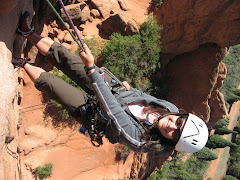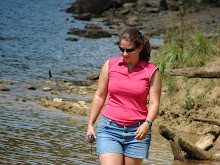
When we went to San Fran we walked across the Golden Gate bridge and in St Louis the Eads Bridge so we decided that bridges are our thing. Sat night we checked the weather and decided that the hurricane was not going to hit us(we were worried we might need to head home early). Then we went to the Clarkson Covered Bridge just outside Cullman.


The bridge itself was constructed in 1904 for the cost of $1,500 on property once owned by J.W. Legg. Originally called Legg Bridge after the original landowner, the structure of the 270-foot bridge was quite unique. It was constructed based upon a design that had been developed and patented by Ithiel Town of Connecticut in 1820. Called the Town Lattice Truss, the bridge building system employed an elaborate framework of lumber that formed a cross pattern similar to that of a garden trellis. The wooden crosses were connected at each intersection by thick double pegs and were connected to large horizontal chords at both the top and bottom of the bridge. This innovative design allowed the bridge to be virtually self-supporting and capable of withstanding tremendous loads without sagging. Clarkson Bridge differs from many other such bridges in that iron carriage bolts were used to connect the lattice framework as opposed to the older design, which called for heavy oak pins.  In 1921, a huge storm snapped the bridge in half, one part remaining in place while the other floated downstream. Washed away by the rain-swollen torrents of Crooked Creek, the lost half of Clarkson Bridge was later found lodged in a narrow spot of the creek bed and was salvaged. The locals worked hard to save the scattered parts of the ruined bridge and were rewarded soon after when the county was able to hire a contractor to repair the bridge using mostly original materials. The cost of the project to repair the bridge, completed one year later, was $1,500.
In 1921, a huge storm snapped the bridge in half, one part remaining in place while the other floated downstream. Washed away by the rain-swollen torrents of Crooked Creek, the lost half of Clarkson Bridge was later found lodged in a narrow spot of the creek bed and was salvaged. The locals worked hard to save the scattered parts of the ruined bridge and were rewarded soon after when the county was able to hire a contractor to repair the bridge using mostly original materials. The cost of the project to repair the bridge, completed one year later, was $1,500.
On June 25, 1974, Clarkson Covered Bridge was named to the National Register of Historic Places. Shortly thereafter, in 1975, the Cullman County Commission restored the site with the help of concerned citizens as part of the American Bicentennial Project, embellishing the grounds with hiking trails, a picnic area, and two period structures built to accent the historical nature of the bridge: a Dogtrot log cabin and a working grist mill.

 In 1921, a huge storm snapped the bridge in half, one part remaining in place while the other floated downstream. Washed away by the rain-swollen torrents of Crooked Creek, the lost half of Clarkson Bridge was later found lodged in a narrow spot of the creek bed and was salvaged. The locals worked hard to save the scattered parts of the ruined bridge and were rewarded soon after when the county was able to hire a contractor to repair the bridge using mostly original materials. The cost of the project to repair the bridge, completed one year later, was $1,500.
In 1921, a huge storm snapped the bridge in half, one part remaining in place while the other floated downstream. Washed away by the rain-swollen torrents of Crooked Creek, the lost half of Clarkson Bridge was later found lodged in a narrow spot of the creek bed and was salvaged. The locals worked hard to save the scattered parts of the ruined bridge and were rewarded soon after when the county was able to hire a contractor to repair the bridge using mostly original materials. The cost of the project to repair the bridge, completed one year later, was $1,500.On June 25, 1974, Clarkson Covered Bridge was named to the National Register of Historic Places. Shortly thereafter, in 1975, the Cullman County Commission restored the site with the help of concerned citizens as part of the American Bicentennial Project, embellishing the grounds with hiking trails, a picnic area, and two period structures built to accent the historical nature of the bridge: a Dogtrot log cabin and a working grist mill.

On Monday(Labor Day) we finally went rock climbing. I had found a new rock climbing park, Hurricane Park Creek, that is actually a city park. It has not been open long and I arranged an 8 hr private lesson on top rope rigging with the park manager, John McCrary. I was kinda scared because he only charged me a third of what the going rate is so I figured this was either the deal of a lifetime or else it was going to really bobo. Luckily it was fabulous. The park is closed on Mondays so we had the whole place to ourselves. John was really nice and very knowledgeable. The park was out of this world. It is 67 acres of hiking, mountain biking and rock climbing and it is gorgeous. I have never seen a city park like this.















No comments:
Post a Comment